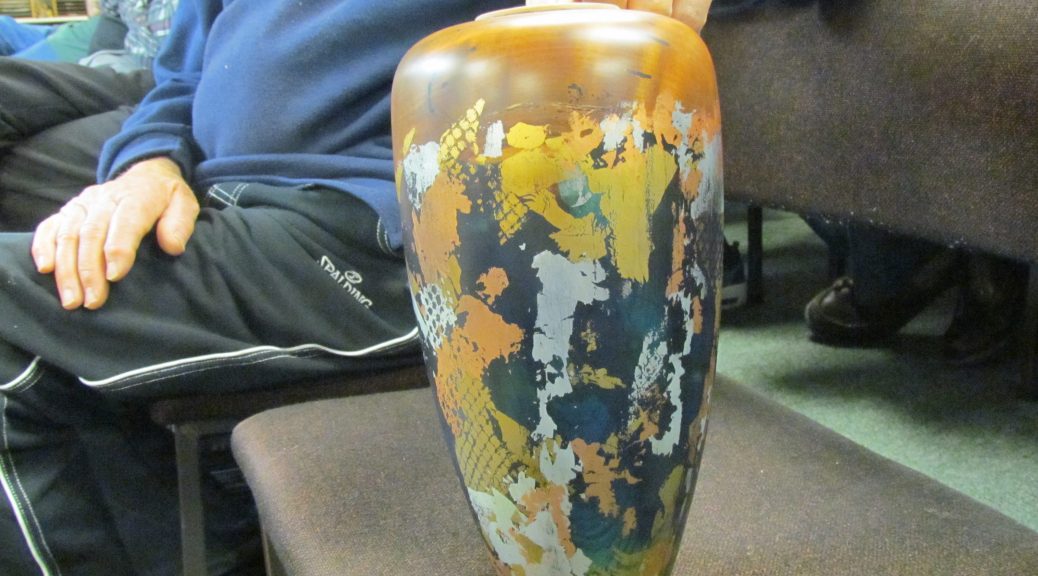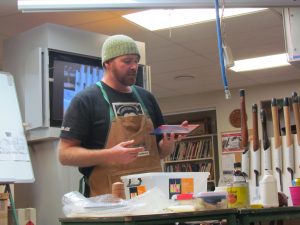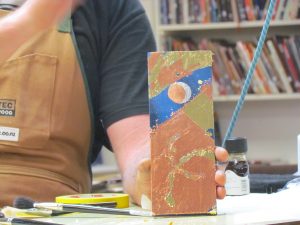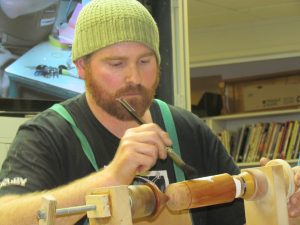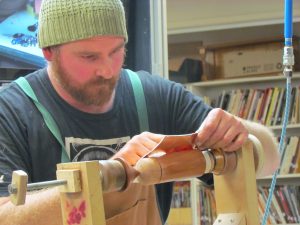Club Meeting: 27 July 2016
Demonstrator: David Gillard
Report by: Graeme Mackay
David’s humour comes through early. He opens a demonstration with this take on gilding and the use of a special gilder’s pinafore or as we commonly known as a pinny. Through this initial humour David started the theme of planning and preparation and time to carry right through the process.
The embellishment process of gilding requires planning: choose a surface, prepare it well, Sand well and make sure the shape is clean. Gilding is an addition or an embellishment. It does not cover up lack of form, mistakes or hiccups.
Checks and steps: overall gilding is a simple process where a medium (size) is used to hold a thin metal foil onto a prepared surface. David stated that it is all in the planning and ensuring that the correct material processes used for each step.
Size; the medium to hold everything together. The use and drying time means checking the type of size and ensuring that you have the correct medium i.e. oil or water-based. Check; the drying time for this type medium when considering the atmospheric temperature and humidity.
Leaf: which one, which type, what are the restrictions. David demonstrated a range of loose-leaf and packet foils in both metals and plastics. And, showing how each one has to be handled, placed with much laughter in the correct place. The key message was try each form and see how it works for the effect you want to achieve.
Sealing the wood: Dave commented on the need to ensure that the base was sealed and cured. He made mistakes and not wiping all the sealant dust off. I repeated the message to think through the finish. What you want to achieve. And as with all demos think through the process and keep the dust away in a normal workshop conditions are means ensuring that the dust filtering processes of their and that the correct material sealant size or shellac finish is available to be used.
Brushes: a small range is useful for starting up David recommended find him brushes with differing densities. Offering that the density dependent on what part of the process you are doing and that cotton buds are a good fill-in for brushes.
Filtering: David felt the filter on the size or of finish was important. He felt that avoiding synthetic materials for filtering and that using natural materials with that option. He was able to purchase some silk cloth offcuts and reasonable price to use for filtering.
Application of size: David suggested that an airbrush would provide a useful application of size and provides an even finish. This is also a follow-up in the comment of filtering the size material before use.
Holding mechanism: David wanted a holding mechanism that provided two hands free for the many processes of gilding i.e. such as applying size, leaf and finishes. The photo below shows a simple mechanism made without advanced workshop machinery or the need for extremely finely detailed precision engineering.
The simple mechanism uses standard timber bolts and turned bits with a simple slide to make quick adjustments. Dave calls the apparatus to hold the piece a fancy F clamp with a base to stop it falling over.
Purchasing the products: another cheerful checklist from David for purchasing size, sealant and leaf. While the reasons for checking the details before purchase were put forward with great humour, the core exercise still important. Nothing the standard and you often pay too much for too little.
What are the specifications of the size?
How many sheets do you get?
What is the actual colour?
What are the dimensions of the sheets?
Why: gilding as a visual tweak
David commented that the visual and embellishment components are part of the planning working up of a piece.
Gilding is an embellishment which can provide a new visual tweak to a piece.
And, more importantly, that this visual tweak is for the view from the outside.
David believes that it is good to get the outside view versus that of the woodworkers or Woodturner.
The demo provided a good reason to try this line of embellishment. There will be a follow-up article on technical parts of entry into embellishment tree gilding.
July 2016
